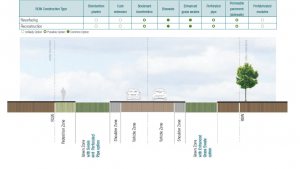Difference between revisions of "LID opportunities in road-right-of-ways"
| Line 16: | Line 16: | ||
===Rural Cross-Section=== | ===Rural Cross-Section=== | ||
[[File:Local Residential Road Rural Cross-section.png|thumb|Residential Road Rural Cross-Section]] | [[File:Local Residential Road Rural Cross-section.png|thumb|Residential Road Rural Cross-Section]] | ||
Local residential streets are the most common street type. They serve as access to the residential lots within those areas created by, or bounded by, thoroughfares, arterials, collectors,and primary residential streets and other physical boundaries such as natural streams and railroads. Since the primary function is local vehicular access rather than intercommunity circulation, theses roads have low traffic volumes and mostly lightweight vehicular traffic, but they must accommodate the rapid access needs of emergency vehicles. Other characteristics specific to the residential rural cross section include: | |||
*Shoulders are grassed, gravel, or bare soil from winter maintenance, pedestrians and street side parking | |||
*Side drainage ditches are often narrow, poorly graded,and can be difficult for homeowners to maintain | |||
*Utilities are often in separate trenches rather than a combined utility trench | |||
Typical opportunities for rural cross section within the roadway: | |||
*Use of permeable pavement within the roadway is not economical when there are adjacent swales to filter and infiltrate runoff | |||
Within the boulevard: | |||
*Bioswales or the use of perforated pipes beneath grass swales can reduce the nuisance problems associated with conventional swales like standing surface water and steep slopes | |||
*Permeable pavement systems can be used to stabilize and improve degraded shoulders | |||
*Converting degraded ditches to enhanced grass swales is the simplest LID improvement to make to residential rural cross-section roads. Driveway culverts can be slightly raised to provide storage and encourage infiltration | |||
==Residential collector road== | ==Residential collector road== | ||
Revision as of 18:05, 25 September 2017
ROW standards in Ontario vary by municipality, but generally there are seven typical ROW types:
- Local residential road
- Residential collector road
- Local industrial road
- Industrial collector road
- Minor arterial
- Major arterial road
- High density commercial road
The characteristics, LID opportunities and constraints, and examples are presented for each of these ROW types on the following pages. Typical LID options for each of these street types are offered. However, this guidance is not intended to be prohibitive of other LID options, but rather to help reduce the number of LID options in the preliminary phases of screening and alert the designer to LID opportunities unique to that road type. Other considerations such as adjacent landuses, traffic demands, utility locations, budget constrains and geological conditions will determine the most appropriate LID solution.
Local residential road[edit]
Rural Cross-Section[edit]
Local residential streets are the most common street type. They serve as access to the residential lots within those areas created by, or bounded by, thoroughfares, arterials, collectors,and primary residential streets and other physical boundaries such as natural streams and railroads. Since the primary function is local vehicular access rather than intercommunity circulation, theses roads have low traffic volumes and mostly lightweight vehicular traffic, but they must accommodate the rapid access needs of emergency vehicles. Other characteristics specific to the residential rural cross section include:
- Shoulders are grassed, gravel, or bare soil from winter maintenance, pedestrians and street side parking
- Side drainage ditches are often narrow, poorly graded,and can be difficult for homeowners to maintain
- Utilities are often in separate trenches rather than a combined utility trench
Typical opportunities for rural cross section within the roadway:
- Use of permeable pavement within the roadway is not economical when there are adjacent swales to filter and infiltrate runoff
Within the boulevard:
- Bioswales or the use of perforated pipes beneath grass swales can reduce the nuisance problems associated with conventional swales like standing surface water and steep slopes
- Permeable pavement systems can be used to stabilize and improve degraded shoulders
- Converting degraded ditches to enhanced grass swales is the simplest LID improvement to make to residential rural cross-section roads. Driveway culverts can be slightly raised to provide storage and encourage infiltration
Residential collector road[edit]
Local Industrial road[edit]
Industrial collector road[edit]
Minor arterial[edit]
Major arterial road[edit]
High density commercial road[edit]
Go back to Screening LID Options
